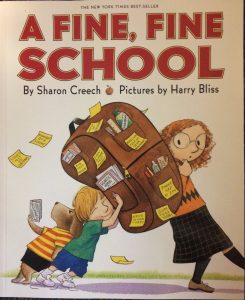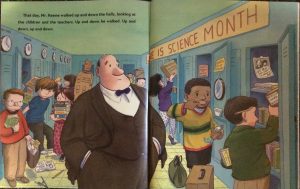Author: Shannon Creech
Illustrator: Harry Bliss
Publisher and Year: HarperCollins Publishers, 2001
Number of Pages: 29 Pages
Genre: Poetry, Fiction
A Fine, Fine School follows Tillie’s school day and all her activities. She attended such a fine, fine school filled with fine, fine students and teachers. The headmaster, Mr. Keene, is so impressed that he begins to declare school on every day of the week and all holidays. Tillie finally speaks up, Mr. Keene sees the exhaustion in the students and teachers, and finally changes school back to normal days of the week.
This text serves as a window into the minds of students in the effects of constantly being tested or always focused on schoolwork. As a mirror, it allows the reader to reflect and critique what “learning” really means. As a door, this text allows the audience the opportunity to see the problems in the school system and redefine what learning really means.
As in any school system, the principal (headmaster) holds the power in how the school functions. The students and teachers did not speak up to Mr. Keene about how they did not want school on weekends and holidays. Mr. Keene continued to include more days in the school year, including the entire summer. Though no culture is completely represented in this book, it does bring to light the issue of the amount of schooling younger children really need. It brings to light a very important issue: how much schooling is really necessary for students to learn? The students continuously look more exhausted and upset as the book goes on, which shows that “learning” in school is becoming pointless because none of the students can focus. When Tillie finally confronts Mr. Keene to tell him that because of so much schooling, she is missing out on learning important things such as learning to climb a tree. In a way, the students are the culture being represented in this story along with the “correct” form of schooling. In addition, the author brings to light another important issue: What is learning? Is learning academic curriculum the only true way of learning? In a creative way, the author emphasizes that learning encompasses more than just academic learning in school.
Perceptually, the images are large showing that the artwork is important (the illustrator is a famous cartoonist for the New York Times). The illustrator illustrates diversity among the students and school subjects. For the reader of this book, he or she can see him or herself represented in the story along with their subject interests. There is a repeat of phrases (fine, fine) showing Shannon Creech’s poetic touch.The text and image sometimes mirror one another by the text telling the story while the images express the emotions of the characters. For example, the post-it notes throughout the story express small messages into how the students are feeling. Through this comedic tale, the author establishes important themes such as learning does not just happen in schools, children need time to be children and explore the outside world, and naivety of administration to get to know students. Finally, this story makes it known that school learning is not fine, fine all the time!


